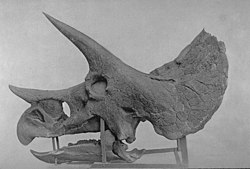Neck frill
This article needs additional citations for verification. (December 2013) |

A neck frill is the relatively extensive margin seen on the back of the heads of
In technical terms, the bone-supported frill is composed of an enlarged
Usage of the neck frill in modern reptiles is better documented. Two chief and disparate examples are the horned lizards (genus Phrynosoma) with a bony frill, and the frill-necked lizard (genus Chlamydosaurus) with a cartilaginous frill. The frill-necked lizard's frill is mainly made up of flaps of skin, which are usually coloured pink, supported by cartilaginous spines. Frill-necked lizards puff out these neck frills on either side of its head when threatened. The lizards often raise their frills when battling for territory or when coming into contact with another lizard, especially during mating season.[1] Acoustic measurements from the frill-necked lizard suggest that the frill does not affect binaural hearing for localization but may increase gain for sounds from directly in front of the lizard.[2]
Numerous other animals of both modern and prehistoric times use both skin or bone protrusions to make themselves seem more threatening, attract mates or to thermoregulate. Examples of these are the usage of dewlaps and crests in lizards, dinosaurs and birds. The unusual red-fan parrot has a feathery neck frill which is used for display purposes.[3]
See also
References
- .
- S2CID 250592592. Retrieved 2023-05-18 – via AIP Publishing.
- ^ "Red-fan parrot or hawk-headed parrot | zoo-ekzo.com- Экзотические животные". www.zoo-ekzo.com.
- Weldon Owen Pty Ltd. (1993). Encyclopedia of animals - Mammals, Birds, Reptiles, Amphibians. Reader's Digest Association, Inc. ISBN 1-875137-49-1.
